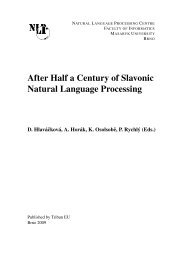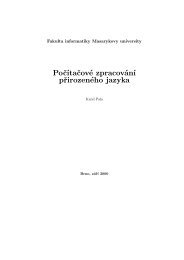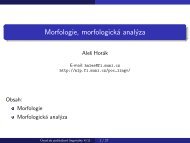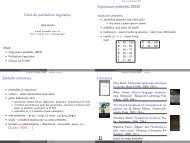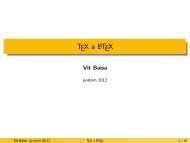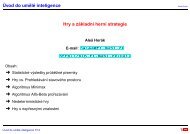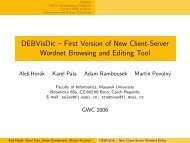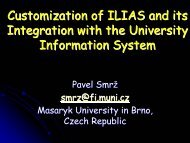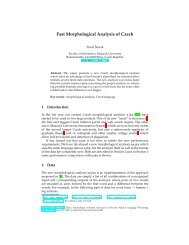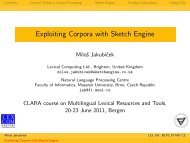GATE: A Unicode-based Infrastructure for Multilingual Information ...
GATE: A Unicode-based Infrastructure for Multilingual Information ...
GATE: A Unicode-based Infrastructure for Multilingual Information ...
You also want an ePaper? Increase the reach of your titles
YUMPU automatically turns print PDFs into web optimized ePapers that Google loves.
the lexicon, the tag returned will be NNP (proper<br />
noun) if capitalised, or NN (common noun) if not,<br />
which is appropriate. However, these heuristics<br />
cannot be changed without modifying the code of<br />
the POS tagger itself, there<strong>for</strong>e we left them unchanged<br />
even though most of them did not apply.<br />
Adapting the tagger did have a number of problems,<br />
mostly associated with the fact that while<br />
the English lexicon (used <strong>for</strong> the tagger) consists<br />
only of single-word entries, the Cebuano lexicon<br />
contained many multi-word entries (such as mahitungod<br />
sa honi (musical)). The tagger expects<br />
lexicon entries to have a single word entry per<br />
line, followed by one or more POS tags, each separated<br />
by a single space.<br />
We there<strong>for</strong>e modified the lexicon so that the<br />
delimiter between the lexical entry and the POS<br />
tag(s) was a “#” rather than a space, and adapted<br />
the tagging mechanism to recognise this. As a result,<br />
the ANNIE POS tagger now has the option<br />
of processing multi-word entries, which are very<br />
important in a number of languages, e.g., the AN-<br />
NIE adaptation to Hindi also required this.<br />
In order to evaluate the portability and usefulness<br />
of such low-overhead adaptation of the<br />
POS tagger, we repeated the same experiment <strong>for</strong><br />
Hindi, using a relatively small English-Hindi bilingual<br />
lexicon. The results were 67% correctness as<br />
evaluated by a native Hindi speaker. Whereas<br />
such correctness may not be sufficient <strong>for</strong> deeper<br />
linguistic processing (e.g., parsing), it is sufficient<br />
<strong>for</strong> named entity recognition.<br />
Next we discuss how these multilingual processing<br />
resources were used to per<strong>for</strong>m in<strong>for</strong>mation<br />
extraction in a variety of languages.<br />
5 In<strong>for</strong>mation Extraction in Multiple<br />
Languages<br />
Robust tools <strong>for</strong> multilingual in<strong>for</strong>mation extraction<br />
are becoming increasingly sought after now<br />
that we have capabilities <strong>for</strong> processing texts<br />
in different languages and scripts. While the<br />
ANNIE IE system in <strong>GATE</strong> is English-specific,<br />
some of the modules can be reused directly (e.g.<br />
the <strong>Unicode</strong>-<strong>based</strong> tokeniser can handle Indo-<br />
European languages), and/or easily customised<br />
<strong>for</strong> new languages (Pastra et al. 02). So far, AN-<br />
NIE has been adapted to do IE in Bulgarian, Romanian,<br />
Bengali, Greek, Spanish, Swedish, German,<br />
Italian, French, Hindi, and Cebuano, and<br />
we are currently porting it to Arabic, Chinese and<br />
Russian, as part of the MUSE project 3 .<br />
5.1 NE in Slavonic languages<br />
The Bulgarian NE recogniser (Paskaleva et al. 02)<br />
was built using three main processing resources:<br />
a tokeniser, a gazetteer and a semantic grammar<br />
built using JAPE. There was no POS tagger<br />
available in Bulgarian, and consequently we<br />
had no need of a sentence splitter either. The<br />
main changes to the system were in terms of the<br />
gazetteer lists (e.g. lists of first names, days of the<br />
week, locations etc. were tailored <strong>for</strong> Bulgarian),<br />
and in terms of some of the pattern matching rules<br />
in the grammar. For example, Bulgarian makes<br />
far more use of morphology than English does,<br />
e.g. 91% of Bulgarian surnames could be directly<br />
recognised using morphological in<strong>for</strong>mation. The<br />
lack of a POS tagger meant that many rules had<br />
to be specified in terms of orthographic features<br />
rather than parts of speech. An example Bulgarian<br />
text with highlighted named entities is shown<br />
in Figure 2.<br />
5.2 NE in Romanian<br />
The Romanian NE recogniser (Hamza et al. 03)<br />
was developed from ANNIE in a similar way to<br />
the Bulgarian one, using tokeniser, gazetteer and<br />
a JAPE semantic grammar (see Figure 3).<br />
Romanian is more flexible language than English<br />
in terms of word order; also agglutinative<br />
e.g. definite articles attach to nouns, making a<br />
definite and indefinite <strong>for</strong>m of both common and<br />
proper nouns.<br />
As with Bulgarian, the tokeniser did not need<br />
to be modified, while the gazetteer lists and grammar<br />
rules needed some changes, most of which<br />
were fairly minor. For both Bulgarian and Romanian,<br />
the modifications necessary were easily implemented<br />
by a native speaker who did not require<br />
any other specialist skills beyond a basic grasp of<br />
the JAPE language and the <strong>GATE</strong> architecture.<br />
No Java skills or other programming knowledge<br />
was necessary. The Gate <strong>Unicode</strong> kit was invaluable<br />
in enabling the preservation of the diacritics<br />
in Romanian, by saving them with UTF-8 encoding.<br />
In order to evaluate the language-independence<br />
of ANNIE’s named entity recognition rules we ran<br />
an experiment comparing the per<strong>for</strong>mance of the<br />
English grammars with the Romanian gazetteer<br />
3 http://www.dcs.shef.ac.uk/nlp/muse/



